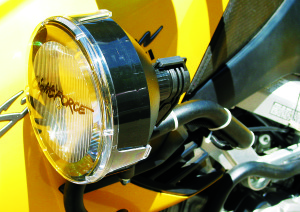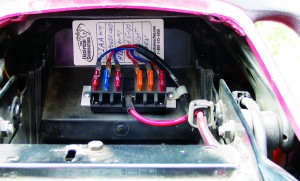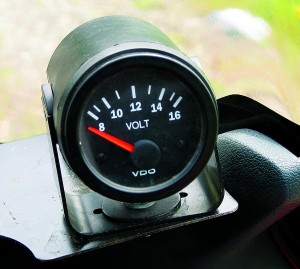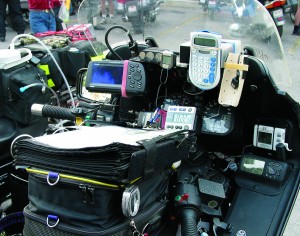If you’re reading this it’s a good bet your favorite form of transportation is a motorcycle, not a car. Even diehard motorcyclists, however, admit there are situations in which some of the comforts of a four-wheeler—heat, music and driving lights—come in handy.
But while adding one or two accessories to your motorcycle is fairly simple, the more circuits you add the greater the potential not only for creating an unsightly maze of wiring sprouting from under your bike’s seat, but draining the battery and overloading the electrical system, as well.
Before you do anything, you need to determine just how much of a drain you can put on your bike’s electrical system without overloading it. If your bike has ever been tested in Rider, look in the spec chart to find the alternator output in watts. You can sometimes also find this information in the shop manual. Let’s say your bike puts out 400 watts maximum. Bear in mind that’s 400 watts at a given rpm, often corresponding to highway speeds in top gear. At lower rpm, such as trolling through town in traffic, the output will be lower.

Next, determine how many watts are consumed running things like lights. Does your bike have one headlight (55 watts) or two (110 watts)? Subtract that from 400, since both headlights are always on. Do the same with the taillight, instrument lights and running lights. These small bulbs don’t use a lot of power, but they add up. Check your shop manual for each bulb’s specifications. Some things, like fuel injection and fuel pumps, will be harder to pin down, and might not be in the manual. But odds are the draw is pretty small.
Now that you know roughly how much of your alternator’s output is used just running the bike, you can tell how much you have left to run accessories. Let’s say you determine that 150 of the 400 watts is accounted for, leaving you 250 watts. An electric vest consumes about 45 watts at full power. A pair of 35-watt driving lights uses another 70. That leaves you a 135-watt surplus, which is a safe margin. Add another vest for your passenger, though, and heated gloves for yourself (about 20 watts per pair) and you’re pushing your luck. Around town or at low rpm you should turn down or switch off some or all of the add-ons to avoid draining your bike’s battery. Even at high rpm and maximum output, you’ll be operating close enough to the edge to put a strain on the electrical system.

Once you’ve done the necessary math, hooking everything up comes next. In theory, the easiest way to power an electrical accessory is to connect it to the battery, negative to negative and positive to positive. But there are two drawbacks to this method. First, the power is always on, even when the ignition’s not, so if you walk away without turning the accessory off, you could come back to a dead battery. Second, you can only attach so many terminals to the battery before you wind up with a confusing tangle of wires that makes it difficult to troubleshoot shorts and blown fuses.
The solution is a power distribution block. Electrical Connection (www.electricalconnection.com) makes three models, one each for GL1500 and GL1800 Gold Wings, and a universal one you can use on just about any bike. They’re hooked up to the battery terminals, but are also connected to the ignition circuit through a relay so the accessories are only powered when the ignition’s on. The universal model has terminals for six accessories, uses common blade-type fuses, and is small enough to mount under the seat or behind a sidecover. Electrical Connection also makes a master ground block so you can route all your ground wires to a single location anywhere on the bike.

As long as you’re wiring things to your motorcycle, now’s a good time to think about adding a voltmeter to monitor your bike’s electrical system’s health, and let you know right away if you’re asking for more power than it can safely give you. Between applications for motorcycles and cars, you’re bound to find one that fits somewhere on your bike. Aerostich (www.aero stich.com) sells several voltmeters, all small enough to mount on the dash or instrument panel of most motorcycles. Most auto-parts stores carry gauges from VDO (www2.vdo.com/vdo) and Stewart Warner (www.stewartwarner.com), both of which make voltmeters that can be mounted flush in a panel, or externally on a bracket.

By choosing the right electrical accessories to add to your motorcycle, you can enjoy the comfort of a heated vest, the sound of an MP3 player, and the safety of driving lights. By connecting them all to a single power distribution box, and using a voltmeter to monitor their power draw, you can avoid turning your bike’s wiring harness into a rat’s nest of wires and fuses. Repairs will be easier, too, as well as adding additional accessories. Just make sure you don’t add too many, though, or else you might discover one more thing cars are good for—bringing you a fresh battery from home.








It’s definitely a good idea to take the proper safety precautions especially for electrical parts.
If you don’t know how much each (currently installed) individual component is using (fuel pump, headlight, blinkers, etc.) but you know the output of the system, is there a way to measure how much “room” you have left?
For example, if I have atypical 439 watt output at 13 volts, is there a way to measure the output “left” to know that I might be using 200 watts right now? So that I can determine I have 239 watts left in this scenario? Obviously have to buy a multimeter or something, but there must be some rough guide to how to do this. Suggestions?
Bought a used bike with added running lights. Power to these added lights is from a wire with an “o” connecter. It is connected alongside the bike’s starter wire, (another “o”) running to the positive battery terminal. Correct? Or should it be on negative terminal?
(There is an on/off switch for these lights, but power comes from battery’s positive terminal hookup… that’s my concern…positive terminal or negative terminal for a one wire accessory hookup?)
Thx.
DC power travels from positive to negative. Positive being more protons than electrons, so the electrons are constantly trying to makeup the difference, think of a higher body of water and lower body of water like a dam, the water will always try to balance itself out through gravity, same concept with electricity you have more on one side than the other constantly flowing from positive ( higher ground water) to negative (lower ground water). So with that in mind there’s a negative mobile ground some where completing the path from positive to negative not just both positives as stated.